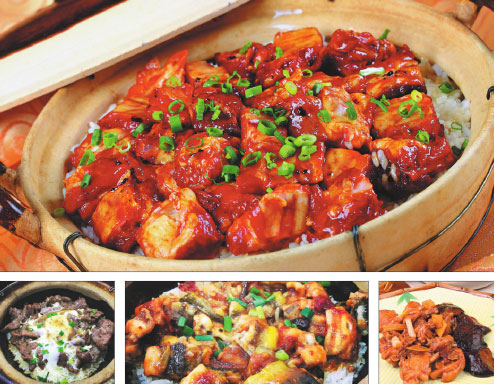Temptation in a clay pot


The winter night was cold and damp. Light rain had lacquered the streets with a shine that reflected the shadows of passers-by huddled into their turned-up collars.
In the dark distance, clouds of steam rose from an open-air food stall, the fragrant fog almost obliterating the surrounding urban landscape.
We were on our way to a midnight supper of clay pot rice. This was at a narrow back alley on Hong Kong island's North Point district, and in those days it was an industrial estate where several media groups had their newsrooms. It was common to hear off-duty newsmen animatedly discussing the next morning's headlines.
Originally eaten as a winter warmer, it is so much a taste of home that it continued its popularity even when the Cantonese migrated to equatorial countries.
The successful art of cooking rice in a clay pot rests on the essential equipment: the clay pot.
This is a rough shallow pot with a handle, unglazed except for the inside. The pot has to be well seasoned so the rice does not stick while cooking. Sometimes, a thick wire is looped around the pot to help it hold together, conduct heat and better withstand the open flames.
Then, there is the fire.
Charcoal was used in the past, but more efficient and environmentally friendly gas is now more common.
The chef has to be a master manipulator with perfect timing.
He has to make sure the bottom layer of rice is cooked through, as well as the savory ingredients on top. Finally, the real test of a good clay pot rice is the slightly burned crust that must come with every pot. Everything depends on how well the fire is controlled.
The rice used is the long-grained perfumed rice that southerners love. Every grain is clearly defined and has none of the lumpy starchiness associated with northern short-grained rice.
In Guangzhou, the best rice is the locally grown simiao variety, named "silky shoots". Unfortunately, production in recent years has been threatened by encroaching urbanization and industrialization in that area.
Imported jasmine rice from Thailand is an expensive substitute.
Rice is cleaned and then put in the clay pot with water, after which it is placed on high heat. When the aroma of rapidly boiling rice rises, the pot is shifted to a lower flame to simmer until the water falls below the surface of the grains.
Next, a plateful of ingredients is carefully spread on top.
The classic combinations are oyster-sauce-marinated chicken and mushrooms, with or without the addition of sweet Chinese sausages, pork ribs in bean sauce, or well-velveted sliced beef that is topped with an egg just before serving. Sometimes, a selection of cured meats is placed on top of the rice and their aromatic fat allowed to leach into the cooking rice.
When the ingredients are cooked by the residual steam, the chef will start toasting the crust by turning the sides of the pot and letting the fire dry out the crust. The best is a crispy crust that is slightly burned but will come away easily from the bottom of the pot.
Just before serving, blanched mustard greens are placed on top.
Then, the whole sizzling clay pot is brought steaming to the table, together with a bowl of seasoned soy sauce.
The diner pours the bowl of sauce over the rice, enjoys the steam created by the meeting of hot rice and sauce, then settles down to a satisfying meal of fluffy fragrant rice, crispy crust, aromatic meats and vegetables.





































